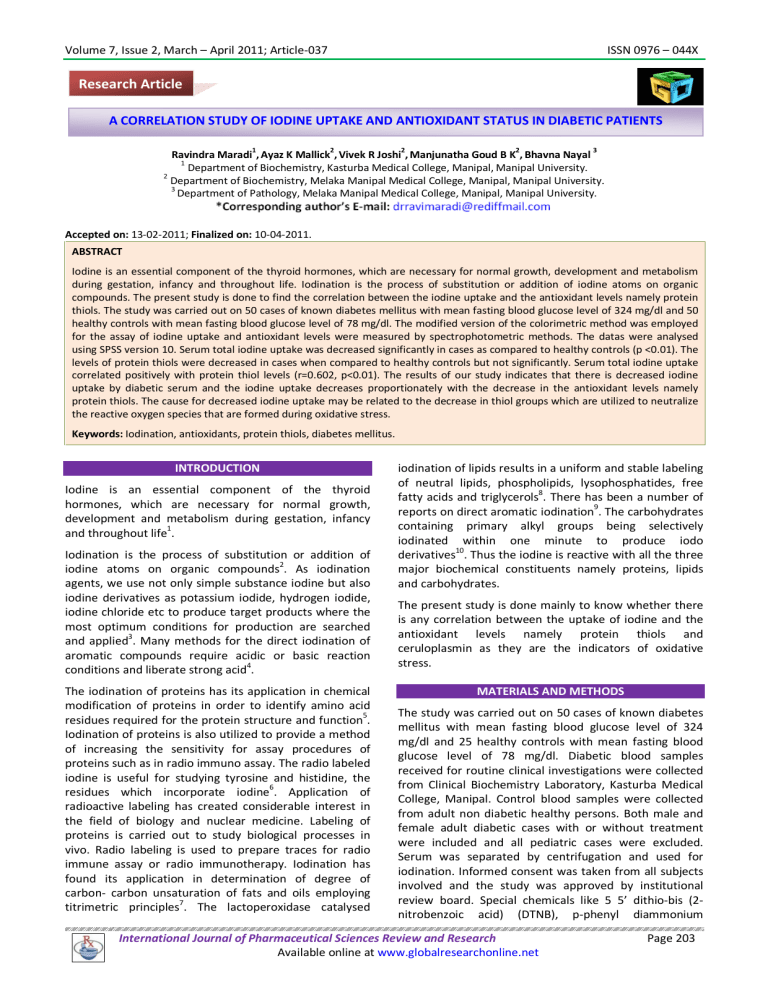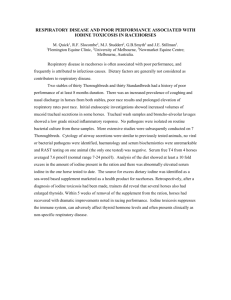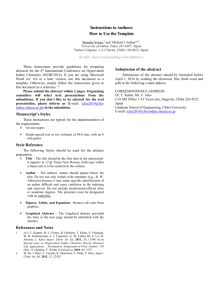Document 13308517

Volume 7, Issue 2, March – April 2011; Article-037 ISSN 0976 – 044X
Research Article
A CORRELATION STUDY OF IODINE UPTAKE AND ANTIOXIDANT STATUS IN DIABETIC PATIENTS
Ravindra Maradi
1
, Ayaz K Mallick
2
, Vivek R Joshi
2
, Manjunatha Goud B K
2
, Bhavna Nayal
3
1
Department of Biochemistry, Kasturba Medical College, Manipal, Manipal University.
2
Department of Biochemistry, Melaka Manipal Medical College, Manipal, Manipal University.
3
Department of Pathology, Melaka Manipal Medical College, Manipal, Manipal University.
Accepted on: 13-02-2011; Finalized on: 10-04-2011.
ABSTRACT
Iodine is an essential component of the thyroid hormones, which are necessary for normal growth, development and metabolism during gestation, infancy and throughout life. Iodination is the process of substitution or addition of iodine atoms on organic compounds. The present study is done to find the correlation between the iodine uptake and the antioxidant levels namely protein thiols. The study was carried out on 50 cases of known diabetes mellitus with mean fasting blood glucose level of 324 mg/dl and 50 healthy controls with mean fasting blood glucose level of 78 mg/dl. The modified version of the colorimetric method was employed for the assay of iodine uptake and antioxidant levels were measured by spectrophotometric methods. The datas were analysed using SPSS version 10. Serum total iodine uptake was decreased significantly in cases as compared to healthy controls (p <0.01). The levels of protein thiols were decreased in cases when compared to healthy controls but not significantly. Serum total iodine uptake correlated positively with protein thiol levels (r=0.602, p<0.01). The results of our study indicates that there is decreased iodine uptake by diabetic serum and the iodine uptake decreases proportionately with the decrease in the antioxidant levels namely protein thiols. The cause for decreased iodine uptake may be related to the decrease in thiol groups which are utilized to neutralize the reactive oxygen species that are formed during oxidative stress.
Keywords: Iodination, antioxidants, protein thiols, diabetes mellitus.
INTRODUCTION
Iodine is an essential component of the thyroid hormones, which are necessary for normal growth, development and metabolism during gestation, infancy and throughout life
1
.
Iodination is the process of substitution or addition of iodine atoms on organic compounds
2
. As iodination agents, we use not only simple substance iodine but also iodine derivatives as potassium iodide, hydrogen iodide, iodine chloride etc to produce target products where the most optimum conditions for production are searched and applied
3
. Many methods for the direct iodination of aromatic compounds require acidic or basic reaction conditions and liberate strong acid
4
. iodination of lipids results in a uniform and stable labeling of neutral lipids, phospholipids, lysophosphatides, free fatty acids and triglycerols
8
. There has been a number of reports on direct aromatic iodination
9
. The carbohydrates containing primary alkyl groups being selectively iodinated within one minute to produce iodo derivatives
10
. Thus the iodine is reactive with all the three major biochemical constituents namely proteins, lipids and carbohydrates.
The present study is done mainly to know whether there is any correlation between the uptake of iodine and the antioxidant levels namely protein thiols and ceruloplasmin as they are the indicators of oxidative stress.
The iodination of proteins has its application in chemical modification of proteins in order to identify amino acid residues required for the protein structure and function
5
.
Iodination of proteins is also utilized to provide a method of increasing the sensitivity for assay procedures of proteins such as in radio immuno assay. The radio labeled iodine is useful for studying tyrosine and histidine, the residues which incorporate iodine
6
. Application of radioactive labeling has created considerable interest in the field of biology and nuclear medicine. Labeling of proteins is carried out to study biological processes in vivo. Radio labeling is used to prepare traces for radio immune assay or radio immunotherapy. Iodination has found its application in determination of degree of carbon- carbon unsaturation of fats and oils employing titrimetric principles
7
. The lactoperoxidase catalysed
MATERIALS AND METHODS
The study was carried out on 50 cases of known diabetes mellitus with mean fasting blood glucose level of 324 mg/dl and 25 healthy controls with mean fasting blood glucose level of 78 mg/dl. Diabetic blood samples received for routine clinical investigations were collected from Clinical Biochemistry Laboratory, Kasturba Medical
College, Manipal. Control blood samples were collected from adult non diabetic healthy persons. Both male and female adult diabetic cases with or without treatment were included and all pediatric cases were excluded.
Serum was separated by centrifugation and used for iodination. Informed consent was taken from all subjects involved and the study was approved by institutional review board.
Special chemicals like 5 5’ dithio-bis (2nitrobenzoic acid) (DTNB), p-phenyl diammonium
International Journal of Pharmaceutical Sciences Review and Research Page 203
Available online at www.globalresearchonline.net
Volume 7, Issue 2, March – April 2011; Article-037 ISSN 0976 – 044X dichloride (PPD) were obtained from sigma chemicals, St
Louis, MO, USA. All other reagents were chemical grade.
The method employed for the assay of iodination is the modified version of the colorimetric method
11
. Normally proteins undergo denaturation when exposed to organic solvents and acidic medium. To avoid denaturation in the modified method, aqueous medium in place of organic solvent and neutral iodine reagent instead of acid was employed. The modified method was also shown to be simple, sensitive and reliable for the detection of iodine uptake by serum. Iodination of serum was carried out at aqueous medium using potassium iodate - iodide mixture as the source of iodine. All the operations were carried out at room temperature in a closed system. 500µl of potassium iodate-iodide solution was mixed with 4ml of
0.5N HCl in a glass stoppered tube. The test tube was kept in dark for 15min for the complete liberation of iodine.
4ml of 0.5N NaOH was added to this and mixed well. It was followed by addition of 0.2M phosphate buffer (pH 7) to make the volume up to 10ml. This reagent was used as neutral iodine reagent.
Protein thiols correlated negatively with fasting blood glucose levels (r=-0.569, p<0.01).
Table 1: Iodine uptake, fasting blood glucose and antioxidants in controls & cases with diabetes mellitus
(mean ± sd).
Iodine uptake
(mg/dl)
Protein Thiols
(µmoles/L)
Fasting blood glucose (mg/dl)
173.96±51.39
315.34±43.91
Figure 1: Correlation between iodine uptake and protein thiols in diabetes mellitus cases.
8000
6000
Controls (n= 25)
7115.44±168.34
250.92±42.25
81.16±9.41
Cases (n= 50 )
4713±318.12 y = 0.7013x + 4591.8
R
2
= 0.0128
4000
To 50µl of serum, 1.950ml of normal s aline was added in a glass stoppered tube. 0.2ml of freshly prepared neutral iodine reagent was added to the test tube and kept in dark at room temperature for 30min for the uptake of iodine. The excess iodine was treated with 2ml of 0.5% starch and the contents were mixed vigorously. The blue color formed was read at 660nm after adding 3ml of distilled water. A blank without sample was also run simultaneously. Considering that under experimental condition, the optical density of the blank is equivalent to
127µg of iodine, the amount of iodine absorbed by the sample was calculated by the difference in optical density of the blank and test. The iodine uptake is calculated in mg/100ml using the formula,
(B-T) × concentration of standard × dilution factor × 100/B
The blood glucose levels were estimated by Cobas auto analyzer using glucose oxidase method.
Serum total thiols were measured by spectrophotometric method using DTNB (DiThiobis NitroBenzoic acid) at 412 nm
12
.
2000
500
400
300
200
100
0
0
0
0
50
50 100 150 200 250
Protein thiols (micromoles/L)
Figure 2: Correlation between fasting blood sugar levels and protein thiols in diabetes mellitus patients.
100 150 200
FBS (mg/dl) y = -0.0331x + 330.34
R
2
= 0.001
250
300
300
350
350
The results were expressed as mean± standard deviation
(SD).P<0.05 was considered statistically significant.
Statistical analysis was performed using the Statistical
Package for Social Sciences (SPSS-10, Chicago, USA).
Independent sample student’s ‘t’ test was used to compare mean values. Pearson correlation was applied to correlate between the parameters.
RESULTS
Serum total iodine uptake decreased significantly in cases as compared to healthy controls (p <0.01). The levels of protein thiols were decreased in cases when compared to healthy controls but not significantly .On applying
Pearson correlation, serum total iodine uptake correlated positively with protein thiol levels (r=0.602,p<0.01).
DISCUSSION
The earlier studies have shown that iodine uptake by serum is due to the iodination of proteins, carbohydrates and lipids. The available reports indicate the existence of iodinated proteins in nature. These include thyroid hormones sponges
15
13
, Scleroproteins
14
, insect cuticles
16
, the proteins present in
etc. The iodination at acidic or basic pH values enhances the attachment of the iodine atom to the sulfur atom of cysteine residues
17
. Ordinarily the mono and di iodination of tyrosyl residues are the principle modification involved in the incorporation of iodine. To a lesser extent iodohistidyl residues are also formed. The oxidizing activity of iodine converts sulfhydril groups to disulfides and may cause some modification of
International Journal of Pharmaceutical Sciences Review and Research Page 204
Available online at www.globalresearchonline.net
Volume 7, Issue 2, March – April 2011; Article-037 ISSN 0976 – 044X tryptophan. In mild alkaline medium iodine reacts with aldehyde group
18
. There has been a number of reports on direct aromatic iodination i.e., by direct formation of a carbon–iodine bond from an iodonium species
19
. The surface membrane lipids are also iodinated through an enzyme-dependent step
20
. In the present the uptake of iodine decreased proportionately with the decrease in the protein thiol levels. The decrease in the protein thiol levels in cases is due to the utilization of thiol groups to neutralize the reactive oxygen species that are formed as a result of oxidative stress in diabetes mellitus. The decreased iodine uptake in cases may be related to the oxidative damage and glycation of biomolecules leading to a possible alteration in the structural conformation causing decrease in the iodine binding sites and resulting in decreased iodine uptake. The iodine uptake is inversely proportional to the blood glucose level and directly proportional to the antioxidant levels.
CONCLUSION
The iodine uptake decreases proportionately with the decrease in the antioxidant levels.
REFERENCES
1.
Kathleen L. Caldwell, Robert Jones, Joseph G. Hollowell.
Thyroid, 15(7);2005: 692-699.
2.
Schulek E, Burger K. Substitutive halogenation of aromatic compounds in aqueous solutions by interhaloids-I:
Halogenating effect of iodine monochloride, iodine monobromide and bromine monochloride. Talanta. vol.1,
Issues 1-2; 1958: 147-152.
3.
Emmanuvel, L.; Shukla, R.K.; Sudalai, A.; Gurunath, S.;
Sivaram, S. NaIO"4/KI/NaCl: a new reagent system for iodination of activated aromatics through in situ generation of iodine monochloride. Tetrahedron Letters,
Volume 47, Issue 28; 2006: 4793-4796.
4.
Abdol R. Hajipour; Arnold E. Ruoho. Iodination of aromatic compounds under mild and solvent-free conditions.
Organic Preparations and Procedures International: The
New Journal for Organic Synthesis, 1945-5453, Volume
34, Issue 6; 2002: 647 – 651.
5.
Carne AF. Chemical modification of proteins. Methods
Mol Biol. 32; 1994: 311-20.
6.
Ghosh D, Erman M, Sawicki M, Lala P, Weeks DR, Li N,
Pangborn W, et al. Determination of a protein structure by iodination: the structure of iodinated acetylxylan esterase. Acta Crystallogr D Biol Crystallogr. 55(4);
1999:779-84
About Corresponding Author: Dr. Ravindra Maradi
7.
Dunn MS, Drell. Experiments in Biochemistry. Ist edn, p.
110. (1951). McGraw-Hill, New York.
8.
Schlager SI. Specific 125I-iodination of cell surface lipids: plasma membrane alterations induced during humoral immune attack. J Immunol. 123(5); 1979:2108-13.
9.
Johnsson R, Andréas Meijer A, Ellervik U. Mild and efficient direct aromatic iodination.Tetrahedron. Volume
61, Issue 49; 2005: 11657-63.
10.
Laurance D. Hall and Jean-Richard Neeser. Fast, mild, and convenient procedures for iodination and bromination of carbohydrates: reactions of organoboranes with iodine monochloride, sodium iodide, bromine, and bromine chloride. Can. J. Chem. 60(16); 1982: 2082–2086.
11.
Shenoy RP,Bolanthur S. Application of bromine and iodine in biochemical analysis; a comparative study with other biochemical parameters [ dissertation ]. Manipal: Manipal
Univ.; 2005.
12.
Motchnick AP et al.Measurement of antioxidants in human blood plasma; Protein thiols, In; Oxygen radicals in biological systems. Methods in enzymology,
Editor Packer L, California: Academic press, vol 234;
1994:273-4.
13.
Meister, A. 1965. Biochemistry of the amino acids, vol. 1, p. 1-199. Academic Press, Inc., New York.
14.
Hunt S, Breuer SW. Isolation of a new naturally occurring halogenated amino acid: monochloro monobromo tyrosine. Biochim Biophys Acta. 1252(2);1971: 401-4.
15.
Welinder BS. Halogenated tyrosines from the cuticle of
Limulus polyphemus (L.). Biochim Biophys
Acta.279(3);1972 :491-7.
16.
Knight LC, Welch MJ. Sites of direct and indirect halogenation of albumin. Biochim Biophys Acta.
534(2);1978: 185-95.
17.
Bates FL, French D, Rundle RE. J. Amer.chem. Soc. 65;
1943:142.
18.
Merkushev EB.Advances in the Synthesis of Iodoaromatic
Compounds. Synthesis 1988; 923-937.
19.
Mersel M, Benenson A, Doljanski F. Lactoperoxidasecatalyzed iodination of surface membrane lipids. Biochem
Biophys Res Commun. 70(4);1976: 1166-71.
20.
Pan HZ, Zhang L, Guo MY, Sui H, Li H, Wu WH,et al. The oxidative stress status in diabetes mellitus and diabetic nephropathy. Acta Diabetol. 2009 May 28.
21.
Maritim AC, Sanders RA, Watkins JB 3rd. Diabetes, oxidative stress, and antioxidants: a review. J Biochem
Mol Toxicol. 17(1);2003: 24-38.
Dr. Ravindra Maradi graduated at JJM Medical College Davanagere, Karnataka, India and post graduated from Kasturba Medical College Manipal, Manipal University, India. At post graduation level taken specialization in Biochemistry. Currently working as Assistant Professor in the department of Biochemistry KMC Manipal since 2008.
International Journal of Pharmaceutical Sciences Review and Research Page 205
Available online at www.globalresearchonline.net





